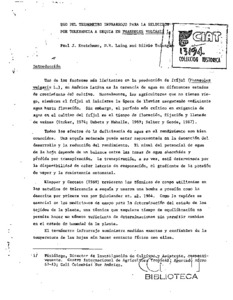Uso del termometro infrarrojo para la seleccion por tolerancia a sequia en Phaseolus vulgaris L.
CIAT has conducted research to develop a method for selecting drought-tolerant genotypes. Bean var. were planted during the dry season. Irrigation was suspended at the initiation of flowering in the dry treatment and the control treatment continued to be irrigated to avoid water shortage. During the dry period, forage temp was determined in both the dry and irrigated treatments using an infrared thermometer between 11:00 and 14:00 6h each day. The differences in foliage temp ( T\248 C) were accumulated for the entire dry period ( T\248 C) and used as the stress index of each dry plot during the period. The relation between the T\248 C and the stomatal resistance and water potential was highly correlated. This suggests that T\248 C can be used as an index of the internal stress level in the plant. Twenty-three lines were selected as drought- tolerant using the percentage yield reduction on dry plots and the T\248 C. If the accumulated differential temp would have been the only criterion used, 65 percent of the 23 lines would have been selected. Certain materials, mainly Type III, had a higher degree of flower abscission under drought conditions but showed a rapid yield recovery due to pod setting from secondary flowers once the stress was suspended. The date of physiological maturity was considerably delayed on dry plots with these late-maturing var. Further research on the described method is required before conclusions can be given on drought tolerance in beans. (AS)

